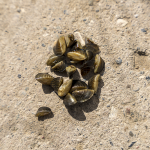Chronic wasting disease persists in Aspen area
Colorado Parks and Wildlife considers this disease to be ‘one of the greatest concerns for deer survival’

Austin Colbert/The Aspen Times
Chronic wasting disease continues to be considered “one of the greatest concerns for deer survival” in Northwest Colorado as Colorado Parks and Wildlife shares recent disease data with The Aspen Times.
CWD is a fatal neurological disease caused by abnormally shaped proteins found in deer, elk, and moose, according to CPW. The disease results in the early death of an infected animal, often within two to two-and-a-half years of infection and significant decreases in survival rates of infected herds over time. Once well established in a herd, CWD is usually impossible to eradicate, according to CPW.
“No immunity develops, and infected animals do not recover,” CPW’s website states.
It is currently well established in herds throughout Colorado.
“CWD is widely distributed across NW Colorado, with CWD detected in mule deer herds in all but one (Data Analysis Unit),” Northwest Region Public Information Officer Rachael Gonzales shared. “There are concerns for CWD prevalence getting too high to be able to manage, as there is direct mortality associated with the disease and transmission can be from nose-to-nose contact, but also CWD prions can persist in the soil.”
To address increasing CWD prevalence in the state, the Parks and Wildlife Commission approved a statewide CWD response plan in 2019: the Colorado Chronic Wasting Disease Response Plan. The plan rotates mandatory testing of hunter-harvested deer around the state for 15 years, and creates a compulsory management threshold of 5% prevalence or higher in adult male deer for when management action must be taken, although the disease can affect both bucks and does.
The primary recommendations to manage CWD prevalence in deer herds where adult male deer prevalence is 5% or higher are:
- Reduce population and density
- Reduce male/female ratios
- Change age structure
- Maximize ability to remove diseased animals at the smallest scale possible (hot spot management)
- Remove motivations that cause animals to congregate
- Minimize prion point sources
- Incorporate CWD management actions and prevalence threshold into herd management plans
As of an April 2025 memo, CPW reports from the 2022 to the 2024 hunting seasons confirm CWD has decreased in four herds, increased in 14 herds, and remained the same in 16 herds.
While D-13, the Maroon Bells deer herd, was under 5% adult male prevalence at 2.5%, other areas in the Northwest Region showed higher percentages from the 2022 to the 2024 hunting seasons memo. D-7, the White River population, was notable at 23.6% adult male prevalence after two rounds of testing and 25% for the third round prevalence estimate. This was the highest prevalence in the northwest areas. D-2, Bear’s Ears, was the next highest at 20.8% adult male prevalence.
CPW outlined increasing buck harvest objectives and licenses, redistributing hunter pressure in later seasons, managing sex ratio to the lower end of the sex ratio objective, and more to help address the higher prevalences.
“Most management actions are related to managing for fewer deer to minimize spread and prevalence, as well as for younger age classes to be resilient to CWD spread,” according to Gonzalez.
Some of the lowest levels of prevalence in the Northwest Region were D-14, Brush Creek, the only area that had no detection, and D-18, Glade Park, and D-53, Basalt, which both had less than 1%.
In 2023, a NW Mule Deer Herd Management Plan was developed. The plan can be found at cpw.widencollective.com/assets/share/asset/z1sjsg2w3w — Northwest Region herds are D01, D02, D03, D06, D07, D08, D09, D11, D12, D13, D14, D18, D41, D42, D43, and D53.
Preps: Golf season ends at state as regional play is underway for tennis
The Aspen and Basalt high school boys golf teams competed Monday and Tuesday in the Class 3A state championships, hosted by Eagle Ranch Golf Club.
Aspen airport sees more delays, cancellations in wake of new wind-reporting policy
A change from instantaneous wind-speed reporting to average wind-speed reporting aligned with a higher rate of flight delays, diversions, and cancellations this summer at the Aspen/Pitkin County Airport.










